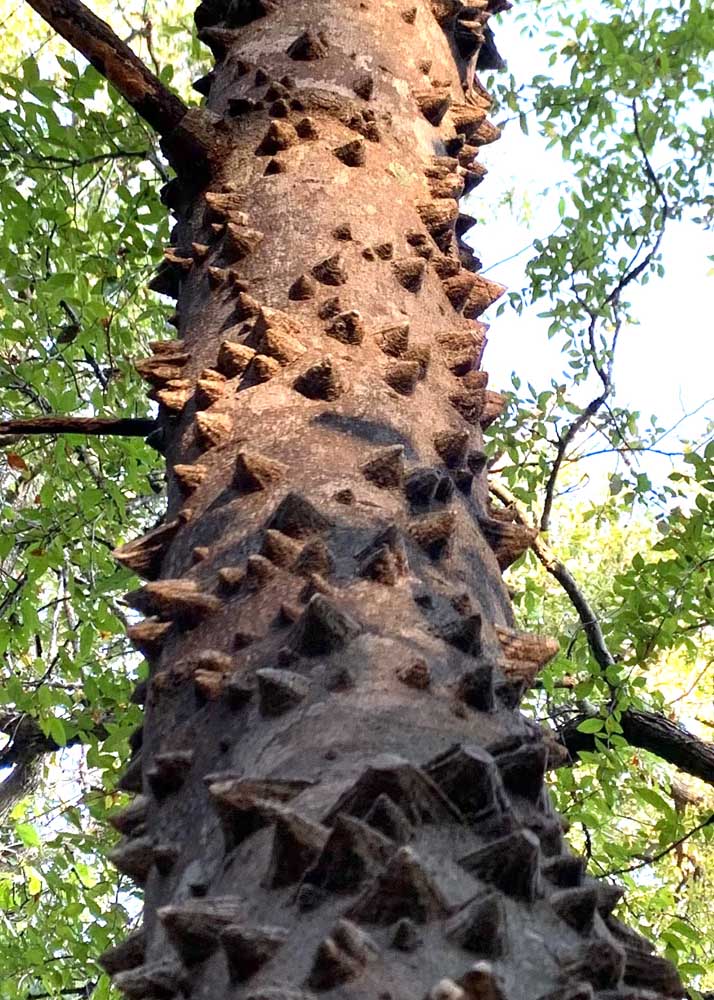Sperry: Learning new plants and diagnosing fall ailments
Published 5:00 am Friday, November 3, 2023

- This tree has several names. Botanically it’s Zanthoxylum clava-herculis, but most call it Hercules club.
Dear Neil: I was on a nature hike in North Texas a week ago and came across this pretty, but really odd-looking little tree. What is it, and would it ever work in a home landscape?
It has several names. Botanically it’s Zanthoxylum clava-herculis. Most of us call it Hercules club, but I’ve also heard it referred to as “tingle-tongue” and “toothache tree” because of the reaction it has with our mouths when chewed. Its leaves, as you saw, are lustrous and attractive, but because of the spines, it probably won’t make anyone’s top list of best small trees for landscaping. However, it’s certainly a conversation starter. And “conservation starter.” The birds love its fruit.
Trending
Dear Neil: Have you encountered nurseries selling lacebark elms as cedar elms? The two are distinctly different. I’ve seen this happening twice in recent weeks. When I point it out, they just shrug their shoulders and move on. What can be done to protect consumers? Aren’t cedar elms the superior trees?
We all need to learn the subtle differences in the two species. Yes, I agree that cedar elms are better landscaping investments. They’re not bothered by cotton root rot, the fatal soil-borne fungus, whereas lacebark elms are. And the same with Dutch elm disease, should it become a major threat across Texas. Lacebarks have trouble holding their plumb habit, often developing severe leans out of vertical.
As far as identifying the two, lacebark elms (Ulmus parvifolia) have more slender leaves, and if the trees are large enough to be displaying bark, they have the unusual coloring of the trunks that gives the plant its name. Cedar elms have “twiggier” growth and more oval leaves that are distinctly more hirsute on their top surfaces. Their trunks have none of the lacy patterns as the bark exfoliates. You asked if I have observed this mixup, and I have not. I deal with veteran nursery people who are very critical of the merchandise they buy. It sounds like someone either bought without actually visiting the wholesale nursery to pick and choose, or they didn’t know the difference themselves.
Dear Neil: My tree has these brown spots on its leaves. Even the green leaves have spots. What is happening? What should I do?
This might have been a fungal leaf spot from a month or two ago, but frankly, it is of no concern. As you can tell, all these leaves are dropping now for the winter. The only thing you might do would be to pick them up and put them into the compost pile to get them away from this plant. There is absolutely no reason to spray anything this late in the season. They might serve as a source of inoculation for next year, but on a scale of threats to your tree, they barely move the needle off “Zero.”
Dear Neil: I’m seeing yellow and brown areas in my St. Augustine. It has looked good all summer and so far this fall, but now the discoloration. I applied insecticide for chinch bugs and seem to have avoided them. What might this be?
Trending
I’m going to guess, due to recent moisture and temperatures dropping, that it’s brown patch (now also being called “large patch”). It’s a fall disease. It appears once temperatures drop into the 50s and 60s. Blades will turn yellow, then brown just a few days later. They will pull loose easily from the runners, and you’ll be able to see the active decay at the bases of the blades. Azoxystrobin fungicide will control brown patch. Water only in early morning, so the grass won’t stay wet overnight.
Dear Neil: I was helping a friend train a nice large crape myrtle tree the other day, and I noticed a stub left over from a prior year’s trimming. It extends out from the trunk by probably two inches, and the original branch has turned very black and cracked. Should I recut that branch a little closer to the trunk for him?
Yes. If the old, blackened limb extends beyond the roll of new bark that the plant is producing to cover the wound, cut it back to the edge of that roll. That will shorten the time it will take the plant to swell the new bark out and over the remnants. I would not cut back far enough that you were cutting into green wood.
Dear Neil: What is this absolutely stunning groundcover I saw at a shopping center recently? It’s not just an annual, is it? (Photo enclosed.)
That’s purpleheart (Setcreasea pallida). It’s a sister to the tropical hanging basket plants known as wandering Jews. Purpleheart is winter-hardy in most winters, but it does die down to the ground with the first freeze. Its electric mid-lavender/purple color just gets more intense as the fall weather cools. It’s also quite tolerant of heat and drought. Nice plant.
Dear Neil: Have you ever seen cedar elm bark scratched and peeled in strings? Two branches have died, apparently because of the loss of bark. There appear to be large areas up in the tree where the bark is gone. What might have caused that kind of damage?
It sounds like squirrel damage. They’re notorious for peeling bark and killing branches, most notably in pecans and live oaks, but you’ll see their damage in other species as well. You’ll see 3-foot areas high up in live oaks and pecans, where all the leaves suddenly turn brown in the summer. On closer inspection, usually with binoculars, you can see that the bark has been stripped as the rodents sharpened their teeth. Some larger beetles will also do modest amounts of bark scoring, but they’re certainly not the prime suspects. I would suggest you hire a certified arborist to look at the issue on-site.





